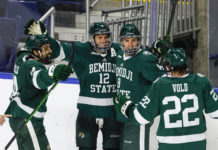Hockey, as an entity, has made a lot of changes in recent years. Attempts to speed up, clean up, and first and foremost increase scoring have been major priorities, especially at the NHL level.
The world’s top league is looking to erase over a decade of trap-happy hockey, where the prevailing philosophy of the sport was to suffocate an opponent into submission while scoring just enough opportunistic goals to eke out the win.
Some of the NHL’s initiatives to this end included: allowing two-line passes; permitting “tagging up” in offsides situations; dictating a renewed emphasis among the officials against holding, obstruction, hooking, and general interference; prohibiting line changes for teams guilty of icing the puck; shrinking goaltenders’ equipment; shrinking the goal crease; creating the trapezoid to limit the territory in which goalies can play the puck; making overtime a four-on-four affair; and instituting the shootout, thereby eliminating ties.
The league even experimented (and may still be doing so, to some extent) with warping the size and/or shape of the goal to create more net to shoot at.
While all of these tweaks and twists have stuck, more or less, there is one adjustment that I believe would have a tremendously positive impact on the way the game is played. The funny thing is, it’s not a new idea … in fact, it was in the NHL rule book half a century ago. Perhaps it’s time to dust off some history and make it our future.
Back in the middle of the century, all penalties were served to their chronological conclusions: players who took two-minute minors served all 120 seconds, regardless of whether – or how often – the opposition scored on the power play. Nowadays, of course, only five-minute major penalties allow for multiple power-play goals for a single infraction.
What changed? Ironically, in 1956-57 the NHL decided that too many goals were being scored, and parity (and to some extent the very relevance of the sport) was under fire.
The Montreal Canadiens were the culprits, dressing lethal combinations of Hall of Fame talent the likes of which had never before graced a sheet of ice. Mythical players like Maurice and Henri Richard, Jean Beliveau, Bernie Geoffrion, Dickie Moore, and Emile Bouchard were so prolific, so immutably and inherently dominant that the league felt it had little choice but to dampen the breakneck scoring pace of the Bleu, Blanc et Rouge goal machine … by redesigning the game at large. (We should also be careful not to disregard the contemporary issue of simmering – and frequently blatant – prejudice against French Canadians, including the province of Quebec, its queen metropolis of Montreal, and of course the culture’s second religion: its beloved Canadiens.)
The NHL got its way, and while it did little to staunch the flow of Stanley Cup titles into Montreal, it did change the game in a big way.
Many among USCHO.com’s audience will astutely point out that the college game in many ways side-stepped the defensive quagmire into which the NHL tumbled in the mid-90’s through the lockout year of 2004-05. The talent is more diluted and rough around the edges, fighting has never been an issue, and rules like no-touch icing (where the defense doesn’t have to contact the puck to draw the whistle) and the two-line pass (which has been legal for a long time in NCAA hockey) keep the pace swift and exciting. That’s all true, and I for one don’t feel that boosting the scoring is an issue for our level of the sport.
But as a general rule of the game, one shared by many if not all levels of play, the full-minor rule could be a big step forward. The obvious result is that scoring will go up as power plays get second or even third goals in a single two-minute advantage. But the secondary effects may be the most appealing: after an early goal glut, it stands to reason that penalties themselves would diminish as coaches and players emphasize staying on even footing.
The current system of law and order puts the onus on the officials to keep a game clean, safe and fair. Rules are enhanced, re-emphasized, and re-defined in the hopes of putting all referees on the same page. In today’s Great Quest for Consistency, focus is on the strict definition of infractions instead of on the penalties’ ramifications.
I believe that we need to shift our focus to address the punishment more than the crime: players know what’s clean and what’s not; they know where the general line is. If the risk (goals against) is weighted a bit more heavily than the reward gained of a questionable action, the frequency of such actions will fall. It’s human nature, and it’s been minimized for too long.
Bring the sport full-circle: add the weight, and watch the game take off.
